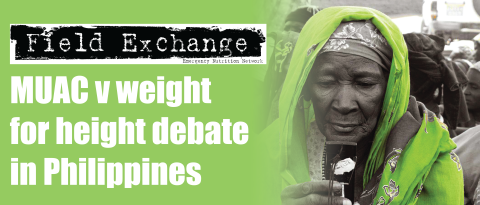Improving patient assessment: The ‘MOYO’ Weight-for-Height Chart

By Marko Kerac and Andrew Seal, UCL Centre for International Health & Development, UK
We are pleased to include with this edition of Field Exchange, a complementary copy of the ‘MOYO chart’. Named after the MOYO1 Nutrition Ward, Blantyre, Malawi where it was originally developed, this is a low cost job aid that helps health workers correctly assess and interpret a child’s weight-for-height.
Background to development
Field Exchange readers will be familiar with the challenges that inspired the chart: a busy nutrition centre, overworked but often underexperienced front line staff, the need to ensure consistent, high quality patient assessment and referral to appropriate treatment. In such settings, optimising each step of the patient care pathway is critical.
The MOYO chart came about as we realised that traditional weight-for-height lookup charts were sometimes part of the problem rather than part of the solution. Adapting and repackaging them into a more user-friendly slide chart format seemed to make a difference2. Following some further refinement, we went on to formally test our new design in a randomised controlled trial in Ethiopia. This showed that the MOYO chart was preferred over traditional charts and enabled significantly (p=0.011) more accurate assessment of nutrional status3. In settings where weight-for-height is still used, it acheives these benefits by guiding healthcaare workers through the process of:
- determining whether to measure standing height or recumbent length
- rounding the length/height measurement appropriately
- allowing easy identification of weight-forheight z-score and correct diagnosis of SAM (Severe Acute Malnutrition) or MAM (Moderate Acute Malnutrition).
- determining an appropriate target weight for discharge (either -2 WHZ or -1 WHZ).
Insert in Field Exchange 42
Two versions of the MOYO chart are currently available, both using 2006 WHO growth standards:
- Boy/Girl split sex chart (as recommended by WHO4 and included with Field Exchange 42)
- Joint sex chart (responding to field demand but awaiting formal testing)
Plentiful white space is available on the chart so that bulk buyers have scope to customise the chart to include local protocols or other locally important text/graphics.
Availabilty
Following this initial distribution via Field Exchange - made possible thanks to a grant from UCL (University College London) Futures Fund - further copies of the MOYO chart are available to buy via the health education charity Teaching Aids at Low Cost (TALC). Unit costs will depend on order size. One hundred per cent of profits from sales of the chart are retained by TALC to support its wider educational objectives. Chart customisation (e.g. with local protocols) is available on request for bulk buyers – contact TALC to discuss your needs: web: www.talcuk.org, email: info@talcuk.org, tel (UK): +44(0) 1727 853 869
We hope you find the chart useful and thank the many people whose comments and suggestions have been critical to its development. Any further feedback to help with future versions is always very welcome: contact Marko Kerac, email: marko.kerac@gmail.com or Andy Seal, email: a.seal@ucl.ac.uk
1’Life’/’Health’ in local language, Chichewa
2Kerac, M, A. Seal, H. Blencowe, and J. Bunn. Improved assessment of child nutritional status using target weights and a novel, low-cost, weight-for-height slide chart. Trop Doct, 2009. 39(1): p. 23-6.
3Sikorski, C., M. Kerac, M. Fikremariam, and A. Seal, Preliminary evaluation of the Moyo chart—a novel, low-cost, weight-forheight slide chart for the improved assessment of nutritional status in children. Transactions of the Royal Society of Tropical Medicine and Hygiene, 2010. 104(11): p. 743-745
4WHO child growth standards and the identification of severe acute malnutrition in infants and children. A joint statement by the World Health Organization and the United Nations Children's Fund. May. 2009 (accessed 19 Sept 2010)]; Available from: http://www.who.int/nutrition/publications/severemalnutrition/9789241598163/en/index.html
Imported from FEX website


 English
English Français
Français Deutsch
Deutsch Italiano
Italiano Español
Español